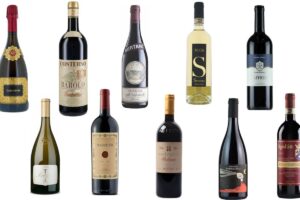The Asian wine world is a myriad of different markets, different consumers, different trends for global wine and its protagonists meet at “Wine Future” in Hong Kong. We shall begin this virtual tour in Japan, with Carl Robinson, CEO of the Importing company “Jeroboam & Co. Ltd”, Tokyo. “Japan has a relatively young history of wine consumption, mainly at restaurants. There are many French and Italian restaurants, which are the top two foreign countries that import wine in Japan. The level of wine culture is excellent and there are also great collectors of fine wines, who unlike the Chinese do not buy wine to “speculate” on the value but rather to drink it. It is an easy-to-market approach; taxes are low and easy to understand”. So, is it a perfect situation? Not really, because despite all the growth in consumption after the boom of the ‘90s, quantity is still holding at 2 liters per capita.
Some of the protagonists of the most important potential Asian wine markets will discuss and interpret the first signs of the future of wine together with major opinion leaders, at “Wine Future” in Hong Kong (November 6-8th, www.winefuture.hk), where WineNews is a “special envoy”. So, let’s begin this virtual tour of Japan with Carl Robinson, CEO of the importing company “Jeroboam & Co. Ltd”, Tokyo (www.jeroboam.co.jp). “Japan has a relatively young history of wine consumption, which is especially paired to the restaurant industry. There are many French and Italian restaurants, which are the two top foreign countries importing wine in Japan.
The level of wine culture is excellent and there are also great collectors of fine wines, who unlike the Chinese do not buy wine to “speculate” on the value but rather to drink it. It is an easy-to-market approach; taxes are low and easy to understand. There are not only great players but also importers and smaller, specialized distributors, and the market offers many levels of service, from storage to distribution”. A positive picture, then, but it is not all “rosy”. Ned Goodwin the only Master of Wine in Japan explains, “the consumer of the Rising Sun is certainly the most sophisticated and attentive to detail in Asia. But foreign observers forecasts are too optimistic: after the boom in consumption in the mid 90’s, there have been 15 years of stagnation, consumption is only 2 liters per capita, and the average price has dropped beneath the blows of the recession that has hit the country. The market is essentially identified with Tokyo, which absorbs 70% of wine consumed”. Nevertheless, there are reasons to be optimistic: they are rapidly going from the Horeca channel to domestic consumption, and if a few years ago sommeliers “decided” taste trends, now there are many more opinion making channels, from the comic strip “Manga” to lifestyle magazines. In other words, visibility in a magazine about luxury is more important than in an important specialized wine magazine.
This is also because in Japan, assessment scores or data from foreign critics are not considered that highly. And, paradoxically, because of the recession the morale of the country is not tops, so the wine consumer has become more curious, more attentive to the synergy of wine and health linked to food; a trend driven mainly by women and a well-educated younger generation”. Just to the west of Japan is China, the largest, and most promising as well as complicated new world wine mecca. “Fifteen years ago, imported wine was sold only in hotels in the larger cities such as Beijing or Shanghai, the traditional channels in China, and in general it was a product considered too expensive and of little interest to the Chinese people”, said Don St. Pierre Jr., Chief Executive Officer of ASC Fine Wines (www.asc-wines.com), the leading importer of fine wines in China. “95% of consumption was based on Chinese wine, which cost max 3-4 euros per bottle. But in a few years things have changed dramatically: in 2005 there were only 180.000 cases of wine imported, now they are up to 1.8 million, 9-liter cases.
France dominates with 7.5 million liters of wine, followed by Australia (2.6 million) and Italy (1.3). The “non traditional” channels have multiplied: there are State companies that import and distribute wine, there are wine stores and the retail sector, there are second-and third-tier cities, and the perception of wine has changed”. So, they do not drink only the great Chateaux wines for thousands of euros or else very cheap wines, but also many bottles between 80 and 100 euros. “The problem is,” adds Don St Pierre, “that the market has grown but so has the “chaos”: there are more than 20.000 operators, many of whom do not have the necessary expertise, and there is much smuggling and counterfeiting. If there were more transparent rules and less counterfeiting, taxes could be lowered to the benefit of producers and Chinese consumers would become more interested and want the best value–for-money wines. And if local producers do not grow in quality, imported wines will increase their market share”.
So, this is yet another confirmation of the possibilities for China to become the “new United States of wine”, which is one of the most important markets for wines from the best quality / price ratio, not just for entry levels or collectible wines. But, perhaps at least initially, it is not a feasible market for everyone.
“The largest wine cellars and wine groups are more likely to see their market grow,” says Ian Ford, of the importing company Summergate (www.summergate.com), because the biggest importers are watching the ones that have available volumes of product and can invest more in building a brand, which is more important than anything else today to sell in China. By 2020, China will probably absorb between 50 and 100 million cases imported”.
But China is not the only Asian giant. To the southwest lies “young” India with 1.2 billion inhabitants, of which 50% under 30 years old. Many of them will be potential wine drinkers and the “middle class”, with good spending capacity will be 450 million people (nearly 8 times Italy, ed)”, says Subhash Arora, President of the Indian Wine Academy and editor of “delWine” (www.delwine.com), the first wine & food newsletter in India, which goes out to 20.000 users each week.
India is very promising and is a candidate to be not only a big market, but also the largest producer in Asia. But it is probably an even more complex market than China. “The market has grown 25% annually over the last 5 years, and is expected to continue for the next 5 years. Today there are 220.000 crates of wine imported: from France 38%, from Italy and Australia 14%. But there is much to be done in order to create a real boom. The first complication is that every single State (India is divided into 28 Federal States and 7 “territories”) has the right to make its own laws on alcohol. For example, the VAT is usually 20%, but in some cases it is even 55%. Not to mention the 150% excise duty, the fact that in some States taxes are calculated based on price and some States are Prohibitionist. The price? Most wines are sold under 3 dollars; retail goes up to $5.00, and at restaurants, $9.00. The wines sold between $50.00 and $500.00 per bottle are less than 1% of the total”. In addition to fiscal and bureaucratic problems, there is also a lack of adequate infrastructure in the wine chain: the chain of wine “cellars are poorly refrigerated, transportation trucks have no ventilation, and so on.
That’s why whoever wants to export wine to India,” adds Arora, “also has to set up long-term partnerships and consultancy offices to close the gaps that are sometimes due to a lack of wine knowledge in general. So, producers come often to India to promote and market, to be seen and to narrate their wine”. There is one thing that unites all the Asian markets (and perhaps the world): personal relationships are as important as the quality of the wine.
Copyright © 2000/2026
Contatti: info@winenews.it
Seguici anche su Twitter: @WineNewsIt
Seguici anche su Facebook: @winenewsit
Questo articolo è tratto dall'archivio di WineNews - Tutti i diritti riservati - Copyright © 2000/2026








































































































































































































